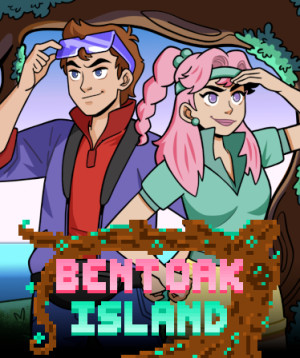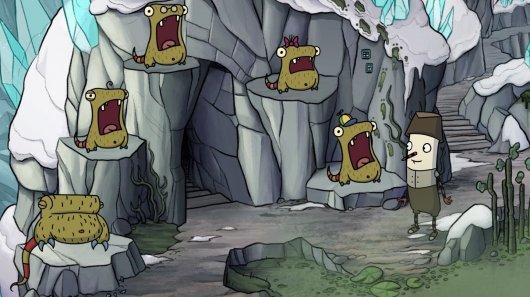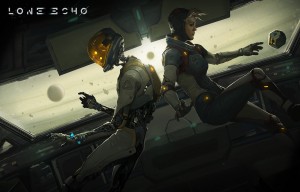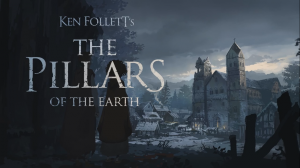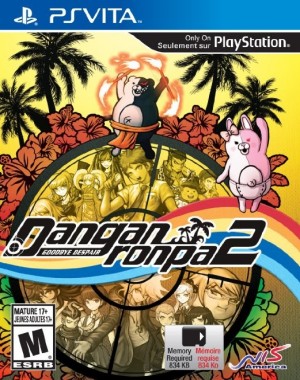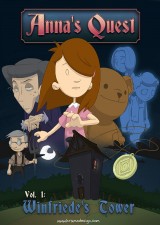Review for The Inner World: The Last Wind Monk
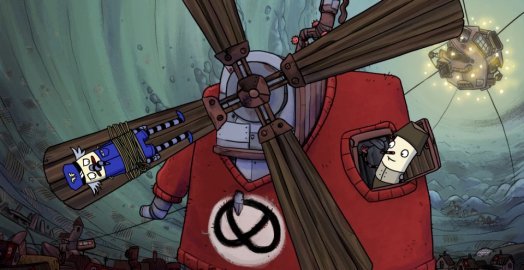
When Studio Fizbin’s The Inner World released in 2013, it was a pleasant surprise: an inaugural adventure from a first-time developer that managed to impress with its charmingly animated characters, clever inventory-based puzzles, and appealing subterranean world. With their follow-up The Last Wind Monk, the German team aims to recreate their success by largely sticking closely to the same formula. This approach works – for the most part – but the sequel ultimately comes up a little wanting in some key areas when compared to its predecessor, primarily by emphasizing a darker tone this time around.
The story begins with a bit of a curveball. In the opening cinematic, we see a throng of Asposians gathered in a town square around their wind fountain, being incited by an orator standing at a podium. Off to his side, a guard stands watch over Laura, the first game’s heroine; and a chained man, a member of the flute nose dynasty who use their woodwind-shaped protuberances to summon the wind that keeps this world-within-the-world alive. It’s been three years since Robert defeated the evil Conroy, who had stilled Asposia’s fountains and petrified the flute noses the first time around. Now a man named Emil has taken control over this underground realm, convinced that the flute noses were the ones who summoned the wind gods and eliminated Conroy, and has embarked on a campaign to round them all up and throw them into the wind fountain as punishment.
This sets a less-than-pleasant tone for the game, making the citizens of Asposia complicit in a manhunt for all flute noses, before turning them over to the state for execution. Robert, as we are shown at the outset, has spent the last three years as a stone statue himself, after running through the woods and tripping over the husk of a Basylian. (This apparently happened off-camera, in the space between games, and I kept waiting for an eventual cinematic to bridge the gap between games and get me up to speed on current events, but to no avail.) The first order of business is to find a way to release Robert from his rock prison by taking control of his trusty pigeon sidekick, Peck.
The game utilizes the same point-and-click mechanics of its predecessor, with contextual environmental options popping up on screen when hotspots are clicked on. After freeing Robert, you are able to control both him and Peck, and later Laura, switching between them via a simple mouse-click. Depending on the scene, players will control one, two, or even all three characters to progress. The trio may be in the same area working together with a shared inventory, or separated and attacking a problem from multiple angles. Each character has their own responses when interacting with objects, and each has a unique ability. Peck, for example, can fly but has no hands, so he will often shoot you a withering glare when asked to do something unrealistic, while Laura is physically stronger than the others, and Robert can manipulate the environment via his wind songs.
Receiving a telepathic message from the mysterious Mama Dola after waking in the forest, Robert is given the task of seeking out the eponymous last Wind Monk, who can restore all Asposians back to peace and harmony. Like its predecessor, the sequel deals with some darker subject matter, seemingly packaged as a children’s game, but then ups the ante. Where the first game saw every Asposian facing a slow and torturous death by asphyxiation, The Last Wind Monk takes those same Asposians and effectively turns them into a mindless mob willing to aid a villain in mass extermination. The rounding up and imprisonment of a race of people, and the fugitive element this creates among the persecuted, contribute to a World War II ambiance that feels excessively heavy and at times uncomfortable.
This gives the game a grimmer, more oppressive mood than before, at least during certain sections, which doesn’t jibe all that well with my recollection of the previous game. It’s also hard to ignore the fact that this setup all but undoes the victory achieved in the first game: the time spent originally exposing Conroy’s evil plot and saving the populace seems like it was all for naught when all of Asposia is willing to hold Conroy up as a martyr and completely turn on Robert and the flute noses. It appears racism and bigotry are alive and well in Asposia.
With all of its dark undertones permeating the atmosphere, The Last Wind Monk does still manage a bit of levity here and there by virtue of the oddball characters and topsy-turvy world. On his journey, Robert crosses paths with – and takes pains to appease – a host of imaginative personalities, including a conductor tied to a windmill wheel, a cactus-enthusiast jailer, and a man with a burger and no ketchup in sight, to name but a few. The lethal-to-all-but-flute-noses gorf is back as well, as are plenty of other colorful fauna and flora. While some of the game’s attempts at humor fall a little flat, they do help to smooth out what would otherwise be a particularly dreary backdrop.
One thing that’s thankfully stayed much the same as last time are the inventory-based puzzles, which still offer up a good challenge from beginning to end. The majority of obstacles demand creative solutions, sometimes requiring multi-step processes to be solved. For example, the first area Robert finds himself in can only be exited via a broken-down cable car. You must collect various parts and tools to repair it, but this proves to be no easy task, involving many steps spread over several screens. While Robert is on his quest to seek out Mama Dola’s assistance in locating the last Wind Monk, Laura pursues a more fist-to-face tactic in order to stop Emil from rounding up all the flute noses. Their objectives frequently overlap, but do occasionally lead them down different paths. Each chapter of the game’s roughly ten-hour playtime is an area contained within itself, usually consisting of three or four locations that interlink with each other for puzzle solutions.
Some assistance is provided where puzzles are concerned. Hotspots can be displayed on-screen to eliminate dreaded pixel hunts, and a step-by-step in-game walkthrough is available via the menu to ensure that no one will remain blocked by any one puzzle for too long. However, a few scenarios are a bit over-the-top in their effort to pose a challenge. In one instance, I was hopelessly stuck despite having a clear idea how to move ahead, simply because my progression was gated until I performed a very specific action, which then caused a chain reaction of solutions I’d already figured out but couldn’t put into effect before. Another time, chasing a rat from its hole in a prison featured a solution that, even after looking it up and following the walkthrough step by step, still made absolutely no sense to me.
An issue I had with the first installment – its hit-or-miss voice-overs – has been noticeably improved here. The actors are by and large good, though there is the occasional instance of a voice not quite matching the character, like the smooth-as-silk voice coming out of Mama Dola’s grizzled and wrinkly face. The voice actors for the primary characters have been kept largely the same, meaning Robert’s nasally whine remains unaltered. A nice connection between games is the voice of Conroy floating into Robert’s subconscious from time to time where no one else can hear it, commenting on events and generally putting him down as often as possible. It’s used to clever comedic effect throughout the adventure, but also shows that Robert’s upbringing at Conroy’s abusive hand still has a lasting effect on his psyche, even after being rid of his influence. Dialog itself, which could feel a bit too much like a chore in the previous game, does a better job of hitting the sweet spot, not short-changing naturally-flowing conversation but also not lingering on it for its own sake.
The music is of a similar quality as before, though perhaps not to the same level of success. The lighthearted cartoony score is well-produced and performed, but lacks any real memorable tracks, apart from the themes carried over from the first game. Art and animation are also quite similar, having a very hand-drawn feel to them. The locales this time around are all new, and include such places as a tumble mouse factory, the hidden temple of the wind monks, and a floating cable car station with an inverted pull of gravity. There’s a level of bleakness to be found here too, however, with the red-sigiled banners and barbed-wire chain link fences adorning some of the backgrounds, rather than the whimsical motifs found in the last game.
At first glance, The Inner World: The Last Wind Monk seems like the perfect follow-up to a delightful first entry. And indeed, it proves to have many similarities, with a story, setting and characters that build directly on what came before. Just beneath the surface, however, this game features a darker and more sinister tone than its predecessor, and though it doesn’t entirely abandon its comic sensibilities, this change does impact the overall ambiance quite a bit. The fairly high quality production values and gameplay are comparable, and the puzzles can be quite challenging, so many of the best parts have been retained for fans of the original. Still, The Last Wind Monk follows the example of some well-known movie sequels and treads a more somber path than the first installment, so time will tell whether it will be remembered as fondly.
WHERE CAN I DOWNLOAD The Inner World: The Last Wind Monk
The Inner World: The Last Wind Monk is available at:
We get a small commission from any game you buy through these links (except Steam).Our Verdict:
Though still an enjoyable adventure with high production values, The Last Wind Monk marks something of a tonal shift in the series. Part of what made The Inner World so appealing was its charm, and the sequel ends up leaving a little of that behind in favor of a darker story full of challenging puzzles.



